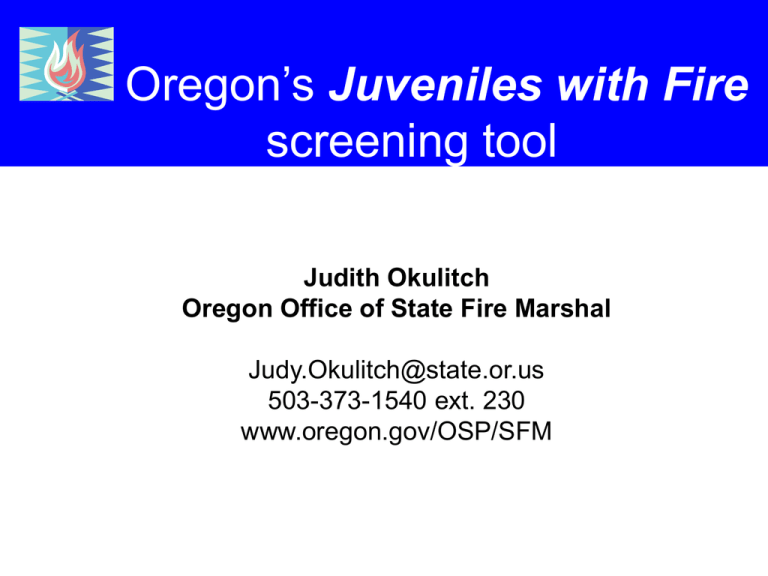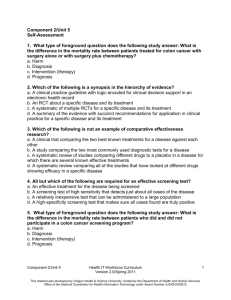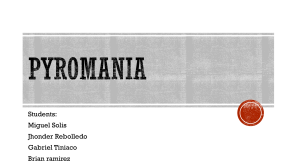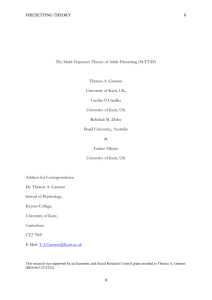Oregon`s Juveniles with Fire screening tool
advertisement

Oregon’s Juveniles with Fire screening tool Judith Okulitch Oregon Office of State Fire Marshal Judy.Okulitch@state.or.us 503-373-1540 ext. 230 www.oregon.gov/OSP/SFM Learning Objectives • To understand the screening process in the intervention of juvenile firesetters • To gain an understanding of the youth’s fire behavior for planning intervention • To practice using Oregon’s Juvenile With Fire screening tool • To identify other high risk behaviors that may correlate with firesetting behavior Know the hat you wear Know the hat you wear Interviewing Interrogation Screening Fire investigator Law enforcement Interventionist Conversation Monologue designed between investigator to get a confession or and youth/parents an admission of guilt which gives info about the fire Format is question and answer Parents don’t need to be present Interview process that uses a set of predetermined questions and is more structured Goal is to help family stay safe and get the child /family help Read Miranda Rights Usually takes place and document after the interview statement and/or interrogation Screening Process • Does not take place until after the youth has admitted to setting the fire. • IS NOT an investigative instrument but the investigator will know many of the answers to the questions • Good idea to partner with investigator for facts of the case • Is part of the intervention program intervention include: Effective firesetter intervention programs • Conducting thorough fire investigations • Screening youth • Developing intervention optionseducation/referrals/safety plans • Implementing partnership plans • Evaluating effectiveness In Oregon . . . The fire service in Oregon determined with their mental health partners the role to play in the assessment process……. Youth Basic Screening Fire Service School Counselor Mental Health Assessment MSW/LCSW/LPC/MS Marriage/Family Therapist School Psychologist Psychological/Psychiatric Evaluation Licensed Psychologist, Ph.D. Psychiatrist, M.D. Fire incident Mental Status Cognitive functioning Fire history Family Functioning Personality traits Fire knowledge Social Functioning Developmental issues Stressors/crisis Psychiatric History Yesterday and Today • Where we have been in Oregon – FEMA/Fineman – Institute on Violence and Destructive Behavior • 130 subjects • Item response theory (IRT) • 7 Key Indicators-family, school, crisis, interpersonal relationships, behavior, prior firesetting history, environmental factors. • Identification of statistically significant behaviors • Development of a screening tool A new screening tool • Uniform tool used statewide to insure credibility • User-friendly • Time-Sensitive • Flexible • Is focused on the fire incident Screening tool • Does not predict risk for future firesetting or to be used in placement • Is not a pyschometric test • Firesetting is ALWAYS a HIGH RISK Behavior--• Must complete a memo of agreement signed by your agency director not to change the instrument or take ownership for it Screening • The fire service has a different mission than mental health providers. • Fire Service Mission--Educate • Mental Health Providers--Treat Screening Tool Booklet • • • • • • • • Intake Form Youth Interview Parent Interview Parent Checklist Scoring and Report Writing Confidentiality Agreement Safety Contract Worksheets Youth Interview 14 Questions: • 3 Questions about school, peers and crisis in family – Is the youth experiencing any school problems? – How does the youth get along with the others in the neighborhood? – Has the family experienced any crisis in the past six months? The fire • 11 Questions focus mainly on the fire What was set on fire? – Where was fire set? – How much planning was done prior to the fire? – Who was with the youth at the time of the fire? – What was the youth’s response to the fire? – How did the youth feel after the fire? – Was the youth supervised when the fire occurred at home? – How knowledgeable is the youth about the fire? – Does the youth have a fire history? – Has the youth been burned? – How concerned was the youth for accepting responsibility for the fire? – How was the fire started? Scoring • Answers to the questions are rated 1-3 – 1 indicates that fire department education would be appropriate intervention (includes safety plans) – 2-3 indicates that more extensive evaluation is needed and safety plans need to be put into place • Keep notes but score after the interview Exercise • In pairs….ask the questions and compile the answers to response #1 ONLY • What do you know about this youth and his/her firesetting behavior? Level I Youth • Where? locations near home, usually in bedrooms, closets, hiding places or forts • How? matches or lighters are readily available • What? tissue paper, leaves, small trash • Behavioral Response? tries to extinguish the fire or calls for help Level I Youth • How does the youth feel? may show remorse • How much planning? may be impulsive • What about fire knowledge? limited knowledge about fire Exercise • In a group of three, have one person ask the question and one person gives the #2 response and the other person gives the #3 response. • What do you know about this youth and his/her firesetting behavior? What do we know about youth who give responses at Level 2/3? • Where? -Fires are set near or around home or places of importance to the community - school,church • What? -Objects burned are symbolic - own possessions or possessions of others -Objects burned may be significant to the community -Directed at a specific person for revenge, out of anger or to show power - Fire may be used as a weapon. Fires • How much preplanning? -The youth went out of the way to collect firesetting materials or may have a “stash” of lighters, matches. -Accelerants are used. -Multiple points of origin. Fires Is there a prior history? -Youth has a history of setting fires - or playing with fire (burning small objects). • • Has there been a crisis? How does the youth get along with peers? - Fires are set in a group with a ring leader. - Peers have a bad influence on youth. Fires • How did the youth respond? -The youth frequently stays to watch the fire. -Doesn’t call for help or becomes the hero. -Youth doesn’t show remorse. -Showed lack of feeling after fire or are really thrilled. -Thinks he/she can control fire. Parent Interview • Information gained from parent and child may differ • Gives you “clues” to know what fire education the family needs “What kind of modeling is going on and what are the cultural or traditional uses of fire in the home?” • Helps identify fire history/early fire experiences Parent Checklist-Self Report • Keeps parents busy but is not busywork • Provides good information for the interviewer and for referral agency • Items are the “red” flags for at-risk kids Red Flag-Behavior • • • • • • Lies Is physically aggressive or violent Destroys own or others’ possessions Is caught fighting or stealing Expresses anger by hurting others/self May be depressed Institute on Violence and Destructive Behavior,University of Oregon 1998 Relationship to Others • • • • • Child is victimized by others Poor loser Shows off for peers Has trouble expressing feelings Friends are a bad influence (older, more delinquent kids) • Has experienced rejection/isolation Institute on Violence and Destructive Behavior, University of Oregon 1998 School Issues • • • • • May be hyperactive Lacks ability to concentrate Acts impulsively Refuses to cooperate Has special education needs, academically or behaviorally Institute on Violence and Destructive Behavior, 1998 Family Issues • Crisis in family • Stability in home is lacking (moves frequently) • History of emotional, physical, sexual abuse • Power struggles with siblings and parents • Adult unavailable to child • Harsh punishment/lack of discipline in home Institute on Violence and Destructive Behavior, 1998 Website and Phone Number www.oregon.gov/osp/sfm (503) 373-1540 ext. 230 or 240








